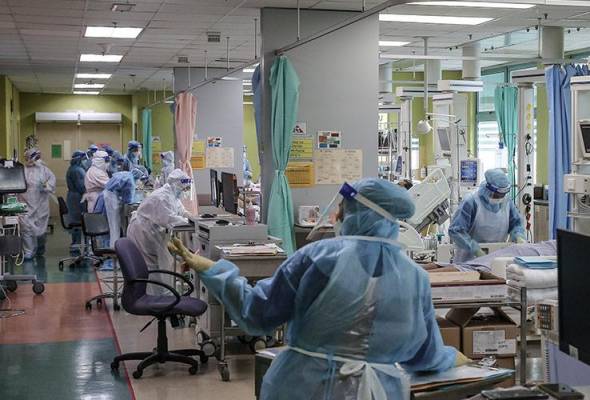
Published in Astro Awani, & Asia News Today, image by Astro Awani.
Despite a month of the first phase of the National Recovery Plan (NRP) which features a full MCO and is still continuing indefinitely, yet not only is there no sign of recovery to move to the second phase when daily infection figures move below 4,000 cases, but also the daily infection numbers are expected to head for the 6,000s in the first half of July, after being in the 5000s for some time.
According to the Health Director-General Tan Sri Dr Noor Hisham Abdullah, this is because the basic reproduction number (R-naught or R0) nationwide has risen to 1.05 as at June 30, which have reversed the downtrend in the daily infection numbers.
He further forecasted based on the current Susceptible-Exposed-Infectious-Removed (SEIR) projection, new cases could breach the 7,000-mark if non-compliance continues and R0 climbs to 1.2. The national R0 number has risen since June 26 at 0.97 to 0.99 on June 27, 1.00 on June 28, 1.04 on June 29 and 1.05 on June 30.Meanwhile, Selangor which time and again has said it has carried the greatest number of Covid-19 testing compared to all the other states, yet it still remains the state with the highest number of daily infections for quite a long time.https://5bc6be01dc6fefeff1fc6f5d22847137.safeframe.googlesyndication.com/safeframe/1-0-38/html/container.htmlWhat actually happened? Is compliance to SOPs the key to a lower daily infection numbers or is testing the key?
It has to be the healthcare system which has reached critical level and in need of an urgent upgrading. In a previous article, EMIR Research has said that reducing social contact to reduce virus transmission in the form of an MCO – whether it is a full MCO or a half-baked one – can only do so much in flattening the infection curve without simultaneously and urgently upgrading the capacity of the healthcare system.
Similarly, an upgraded healthcare system also can do only so much without some form of curbs being implemented in the form of an MCO to reduce social contacts. These two are the crucial preventative measures that must go hand-in-hand and concurrently in order to see results in the form of lower daily infection figures.
So, what are the elements of the healthcare system that need to be upgraded and improved on? At the height of the pandemic in Wuhan, the Chinese government built two hospitals in a matter of just over a week, completed in early February 2020, with a combined capacity of 2,500 beds. The battle against the virus then took a turning point for the better despite about two weeks of a draconian lockdown prior to the hospitals being built.
Malaysia doesn’t have to do this especially if it doesn’t have the technology to build hospitals in over a week. It can upgrade the capacity of its healthcare system through other means but whatever that other means are, time is of the essence as proven by the Wuhan experience.
The RM40 billion Pemerkasa Plus stimulus was announced on May 31 with an RM5 billion injection where quite a huge chunk of it went to upgrading the capacity of the healthcare system in the form of increasing hospital beds and procuring equipment for intensive care units (ICU) including at teaching hospitals of public universities at military field hospitals, in addition to expenditure for appointing more contract manpower for the healthcare sector.
This was supposed to alleviate the rate of bed usage in ICU which is at a critical level to a moderate level for the second phase of the NRP to kick in. But one month has passed since the announcement of Pemerkasa Plus, and the bed usage at ICU still remained at a critical level.
The Health Ministry (MOH) needs to expedite urgently this aspect of the upgrading of the capacity of the healthcare system in a matter of a few weeks, not months because there is a direct relationship between this aspect and all the other aspects of the said upgrading.
When bed usage in the ICUs is at a critical level, doctors would have to resort to triage – a process of determining the priority of patients’ treatments by the severity of their condition or likelihood of recovery with and without treatment – resulting in an increase in the number of deaths.
Similarly, more testing is needed in two critical events – firstly, when a new variant is discovered elsewhere to ensure whether the new variant has entered the country or not, and secondly, when the infection curve has started to flatten, relatively more testing will prevent the flattened curve from rising and may even ensure the flattening of the curve to its floor i.e. zero infection.
But more testing will come to nought if bed usage at the hospital remains at a critical level because the healthcare system cannot cope with the expected rise in the daily infection numbers that immediately followed increased testing.
In other words, people who need medical attention is not attended to, and this will only contribute to not only a rise in the daily infection numbers, but also an increase in the daily death rate and a decrease in the recovery rate.
This is perhaps the reason why despite increased testing, Selangor remains the state with the highest number of daily infections. The obvious reason for this state of affair must be its healthcare system which is in a dire need of capacity upgrading.
So, all aspects of upgrading the capacity of the healthcare system are intertwined which means all these aspects must be attended to urgently and concurrently. We just cannot afford to pick and choose.Once the capacity upgrading is done with urgency and concurrency, the change in the rate of bed usage in ICUs from a critical level to a moderate level will be a breeze, and the daily infection numbers will follow suit in decreasing swiftly.There is, however, one psychological factor that has to be factored in, when capacity upgrading is pursued, and this relates to a high morale of the healthcare frontliners.
Just like in sports where we can see it is the high morale of the England team that has enabled it to qualify for the quarter final of the current Euro 2020 soccer tournament by beating teams with highly skilled and talented players, in the same token, the capacity upgrading of the healthcare system must have frontliners with a high morale.
In other words, the “software” aspect of the healthcare infrastructure is equally critical as the “hardware” – both should be accorded equal attention and priority.
According to the MOH’s recent survey among 893 health workers, exhaustion from long working hours and pandemic fatigue for more than one year have caused many of them to suffer from severe burnout.
Out of the 893 respondents, over half of them reported personal-related burnout, followed by 39.1 per cent from work-related burnout while 17.4 per cent experienced patient-related burnout.
The above statistics points out to a low morale, and the overarching cause of this low morale is actually directly related to the grouses of the contract medical workers at the frontline who have organised the Code Black campaign for contract doctors by wearing black and switching their social media profile pictures to monochrome since yesterday (July 1).The campaign, organised by the Malaysian Medical Association’s Section for House Officers, Medical Officers and Specialists (Schomos), encourages individuals or companies to go black from July 1 to 12. On the final day, people are asked to go to work dressed in black.
These grouses which started five years ago under the Barisan Nasional (BN) government which did nothing to solve the problem continue to fester under both the Pakatan Harapan (PH) government, and the present Perikatan Nasional (PN) government.
The important lesson from this episode is that problem should be nipped at the bud by both the BN and PH governments when there was no bigger problem like the current pandemic, instead of bequeathing the problem to their successor, especially when the country is in the midst of a perfect storm of a pandemic and economic downturn.
Thus, it is in the interest of the current PN government to swiftly bring the problem to an end in order to raise the morale of the medical frontliners, come what may!
Jamari Mohtar is Director, Media & Communications at EMIR Research, a think tank focused on strategic policy recommendations based on rigorous research.

